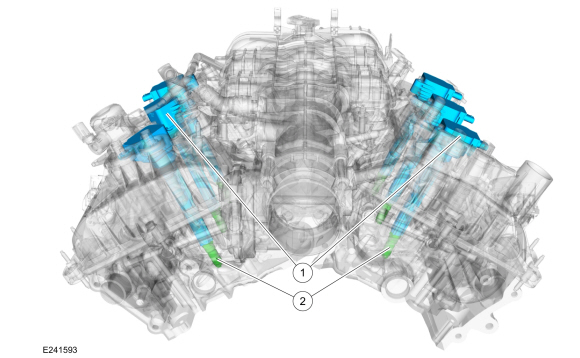Lincoln Navigator: Engine Ignition - 3.5L EcoBoost (272kW/370PS) / Engine Ignition - Component Location. Description and Operation
Lincoln Navigator 2018-2025 Workshop Manual / Engine / Engine Ignition - 3.5L EcoBoost (272kW/370PS) / Engine Ignition - Component Location. Description and Operation
3.5L EcoBoost

| Item | Description |
|---|---|
| 1 | Ignition coil-on-plug(s) |
| 2 | Spark plug(s) |
 Specifications
Specifications
General Specifications
Item
Specification
Spark plug
12405
Spark plug gap
0...
 Engine Ignition - System Operation and Component Description. Description and Operation
Engine Ignition - System Operation and Component Description. Description and Operation
System Operation
Cold Start Emission Reduction Monitor
The
cold start emission reduction monitor is an on board strategy designed
for vehicles that meet the low emissions vehicle-II (LEV-II) emissions
standards...
Other information:
Lincoln Navigator 2018-2025 Workshop Manual: Charging System - 3.5L EcoBoost (272kW/370PS) - Overview. Description and Operation
Overview The generator is driven by the FEAD belt. When the engine is started, the generator begins to generate AC voltage which is internally converted to DC voltage. The DC voltage level is controlled by the voltage regulator (located on the rear of the generator) and is supplied to the battery...
Lincoln Navigator 2018-2025 Workshop Manual: Second Row Center Seatbelt Buckle. Removal and Installation
Removal NOTE: Removal steps in this procedure may contain installation details. Remove the second row center seat. Refer to: Second Row Center Seat (501-10B Second Row Seats, Removal and Installation). If equipped...
Categories
- Manuals Home
- 4th Gen Lincoln Navigator Service Manual (2018 - 2025)
- Windshield Washer Pump. Removal and Installation
- Head Up Display (HUD) Module Calibration. General Procedures
- Brake Service Mode Activation and Deactivation. General Procedures
- Front Bumper Cover. Removal and Installation
- All Terrain Control Module (ATCM). Removal and Installation
Wheel to Hub Runout Minimization. General Procedures
Check
NOTE: Wheel-to-hub optimization is important. Clearance between the wheel and hub can be used to offset or neutralize the Road Force® or run-out of the wheel and tire assembly. For every 0.001 inch of wheel-to-hub clearance, the Road Force® can be affected between 1 and 3 pounds depending on the tire stiffness.
NOTE: The example below illustrates how the clearance between the wheel and the hub can be used to offset the high spot of radial run-out or Road Force®. Following the procedure will make sure of the best optimization.
Position the wheel and tire assembly on the vehicle so that the high spot location of radial run-out or Road Force® is at the 6 o'clock position andCopyright © 2025 www.linavigator4.com
